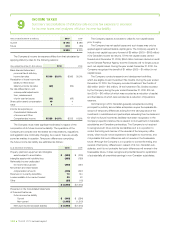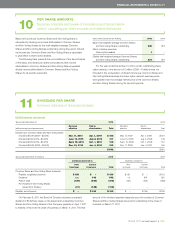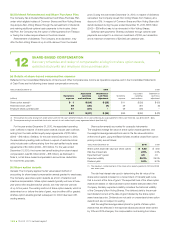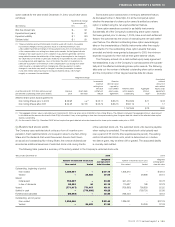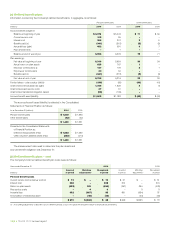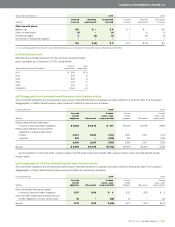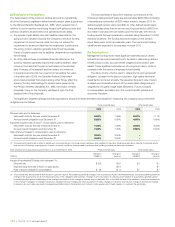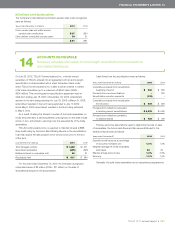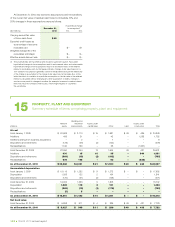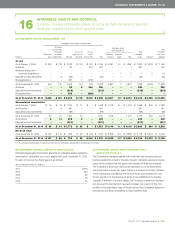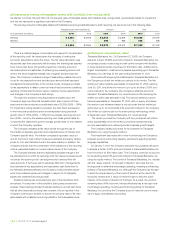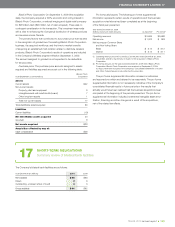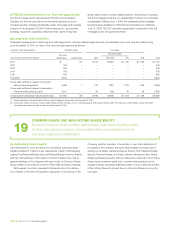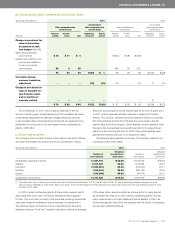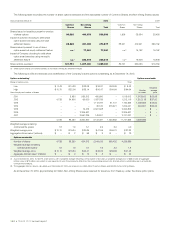Telus 2010 Annual Report Download - page 154
Download and view the complete annual report
Please find page 154 of the 2010 Telus annual report below. You can navigate through the pages in the report by either clicking on the pages listed below, or by using the keyword search tool below to find specific information within the annual report.
150 . TELUS 2010 annual report
The best estimates of fiscal 2011 employer contributions to the
Company’s defined benefit plans are approximately $298 million (including
a discretionary contribution of $200 million made in January 2011) for
defined benefit pension plans and $NIL for other defined benefit plans.
These estimates (other than for the non-recurring contribution of $200 mil-
lion made in January 2011) are based upon the mid-year 2010 annual
funding reports that were prepared by actuaries using December 31, 2009,
actuarial valuations. The funding reports are based on the pension
plans’ fiscal years, which are calendar years. The next annual funding
valuations are expected to be prepared mid-year 2011.
(k) Assumptions
Management is required to make significant estimates about certain
actuarial and economic assumptions to be used in determining defined
benefit pension costs, accrued benefit obligations and pension plan
assets. These significant estimates are of a long-term nature, which is
consistent with the nature of employee future benefits.
The discount rate, which is used to determine the accrued benefit
obligation, is based on the yield on long-term, high-quality fixed term
investments, and is set annually. The expected long-term rate of return
is based upon forecasted returns of the major asset categories and
weighted by the plans’ target asset allocations. Future increases
in compensation are based upon the current benefits policies and
economic forecasts.
(j) Employer contributions
The determination of the minimum funding amounts for substantially
all of the Company’s registered defined benefit pension plans is governed
by the Pension Benefits Standards Act, 1985, which requires that, in
addition to current service costs being funded, both going-concern and
solvency valuations be performed on a specified periodic basis.
.Any excess of plan assets over plan liabilities determined in the
going-concern valuation reduces the Company’s minimum funding
requirement of current service costs, but may not reduce the
requirement to an amount less than the employees’ contributions.
The going-concern valuation generally determines the excess
(if any) of a plan’s assets over its liabilities, determined on a projected
benefit basis.
.As of the date of these consolidated financial statements, the
solvency valuation generally requires that a plan’s liabilities, deter-
mined on the basis that the plan is terminated on the valuation
date, in excess of its assets (if any) be funded, at a minimum,
in equal annual amounts over a period not exceeding five years.
In the latter half of 2009, the Canadian Federal Government
announced proposals that would, among other things, affect the
solvency funding methodology for pension plans governed by
the Pension Benefits Standards Act, 1985; the impact of these
proposals, if any, on the Company will depend upon the final
enacted form of the proposals.
The significant weighted average actuarial assumptions arising from these estimates and adopted in measuring the Company’s accrued benefit
obligations are as follows:
Pension benefit plans Other benefit plans
2010 2009 2010 2009
Discount rate used to determine:
Net benefit costs for the year ended December 31 5.85% 7.25% 5.67% 7.11%
Accrued benefit obligation as at December 31 5.25% 5.85% 4.97% 5.65%
Expected long-term rate of return(1) on plan assets used to determine:
Net benefit costs for the year ended December 31 7.25% 7.25% 2.50% 3.00%
Accrued benefit obligation as at December 31 7.00% 7.25% 2.50% 2.50%
Rate of future increases in compensation used to determine:
Net benefit costs for the year ended December 31 3.00% 3.00% – –
Accrued benefit obligation as at December 31 3.00% 3.00% – –
(1) The expected long-term rate of return is based upon forecasted returns of the major asset categories and weighted by the plans’ target asset allocations (see (g)). Forecasted returns
arise from the Company’s ongoing review of trends, economic conditions, data provided by actuaries and updating of underlying historical information.
2010 sensitivity of key assumptions (year ended, or as at, December 31, 2010) Pension benefit plans Other benefit plans
Change in Change in Change in Change in
(millions) obligation expense obligation expense
Impact of hypothetical 25 basis point decrease(1) in:
Discount rate $ß219 $ß20 $ß1 $ß–
Expected long-term rate of return on plan assets $ß16 $ß–
Rate of future increases in compensation $ß 26 $ß 5 $ß– $ß–
(1) These sensitivities are hypothetical and should be used with caution. Favourable hypothetical changes in the assumptions result in decreased amounts, and unfavourable hypothetical
changes in the assumptions result in increased amounts, of the obligations and expenses. Changes in amounts based on a 25 basis point variation in assumptions generally cannot
be extrapolated because the relationship of the change in assumption to the change in amounts may not be linear. Also, in this table, the effect of a variation in a particular assumption
on the change in obligation or change in expense is calculated without changing any other assumption; in reality, changes in one factor may result in changes in another (for example,
increases in discount rates may result in increased expectations about the long-term rate of return on plan assets), which might magnify or counteract the sensitivities.


